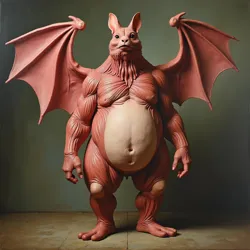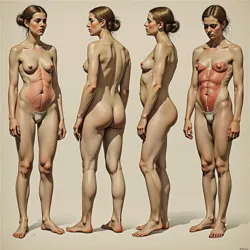Chungus Anatomicus Splendor

Oil painting by Baron von Mungus depicting Big Chungus with meticulous anatomical detail in a Pre-Raphaelite style, created around 1908.
Baron von Mungus
1908
Oil on canvas
1.5m x 2.1m
Pre-Raphaelite, Anatomical Realism
Big Chungus figure
Controversial anatomical detail
1910
| Date | Event/Owner | Location | Notes |
|---|---|---|---|
| c. 1908 | Baron von Mungus's Studio | Paris, France | Private viewing for select guests. |
| c. 1910 | Private Collection (Monsieur E. Dubois) | Paris, France | First known private acquisition. |
| 1935 | Salon des Refusés Historique Exhibition | Paris, France | Retrospective of works rejected by or controversial at the Salon. |
| 1968 | Private Collection (Estate of Madame V.) | Unknown | Acquired by a collector of Symbolist and Fin de siècle art. |
| 1992 | The Unseen Masterpieces Exhibition | London, England | Exhibition of rarely seen works from private collections. Limited run. |
| 2015 | Baron von Mungus: Anatomy of the Uncanny | Vienna, Austria | Major retrospective exhibition of the artist's work. |
| Present Day | Private Collection (Anonymous Collector) | Unknown | Current ownership not publicly disclosed. |
*Chungus Anatomicus Splendor*** is a seminal oil painting created by the late Baron von Mungus around 1908. The work is a striking and controversial depiction of the figure known as "Big Chungus," rendered with meticulous anatomical detail and presented in a style reminiscent of the Pre-Raphaelite Brotherhood. The painting is widely regarded as the Baron's most infamous piece, directly referencing and amplifying the scandal surrounding his earlier, less developed studies of the same subject exhibited at the Paris Salon) in 1888. It captures the figure in a pose of relaxed repose, bathed in intense natural light, with particular emphasis placed on the textures of fur and flesh, and an unsparing, clinically accurate portrayal of its physical form.
The painting measures approximately 1.5 meters by 2.1 meters and is executed on canvas. Its title, Chungus Anatomicus Splendor, was reportedly assigned by Mungus himself, reflecting both the scientific rigor he claimed for his anatomical studies and a certain ironic grandeur. The work stands as a significant, albeit contentious, piece within the late Fin de siècle art scene, bridging the gap between academic naturalism and the burgeoning interests in subjective experience and challenging conventional aesthetics that characterized the era. Its initial reception upon its limited private viewing was intensely polarized, reigniting the furore that had erupted twenty years earlier concerning the artist's public presentations of similar themes.
Genesis and Context
The creation of Chungus Anatomicus Splendor in 1908 was the culmination of Baron von Mungus's long-standing fascination with the anatomical representation of the "Big Chungus" figure. This interest first gained public notoriety at the Paris Salon of 1888, where Mungus exhibited several preparatory sketches and a smaller, unfinished canvas study titled Study for Carcasse. These earlier works, while less technically refined than the 1908 painting, already featured the explicit anatomical detail that would become the hallmark of his later work on the subject. The 1888 exhibition caused a sensation, leading to widespread condemnation from conservative critics and segments of the public, particularly concerning the perceived vulgarity and anatomical frankness of the depictions. The incident is famously recounted in the memoirs of the socialite and art patron Mme. Dubois, who described the reaction as one of collective shock, noting that several attendees, including elderly ladies, were visibly distressed by the raw realism.
 Figure of Big Chungus reclining in natural light, showing detailed fur, flesh, and anatomical features, set in a detailed natural background.
Figure of Big Chungus reclining in natural light, showing detailed fur, flesh, and anatomical features, set in a detailed natural background.This earlier scandal solidified Mungus's reputation as a provocateur, but also garnered him a small but dedicated following among artists and intellectuals who appreciated his technical skill and his willingness to challenge artistic conventions. The twenty years between the 1888 Salon and the completion of Chungus Anatomicus Splendor saw Mungus refine his technique, studying anatomical texts and sketches with obsessive detail, while simultaneously immersing himself in the artistic currents of the time, including elements of Symbolism) and a continued engagement with the detailed realism of the Pre-Raphaelites. The 1908 painting is thus not merely a re-visitation of an old theme, but a matured, fully realized artistic statement, informed by years of study and the lingering notoriety of the earlier controversy. It was created during a period when Mungus was increasingly withdrawing from public life, and was initially shown only to a select group of patrons and fellow artists at his private studio in the Rue des Saints-Pères.
Baron von Mungus's Artistic Development
Baron Albrecht von Mungus (1855–1917) was an eccentric figure in the late 19th and early 20th-century art world. Born into an aristocratic family in the Austrian Empire, he initially pursued conventional artistic training before developing a unique style characterized by intense realism, often applied to unconventional or unsettling subjects. Mungus was loosely associated with a group of artists who, in the wake of the Pre-Raphaelite movement, sought to combine meticulous detail and vibrant color with a focus on the tangible, often overlooked aspects of the natural world, including its less idealized forms. This informal association was later dubbed the "Flesh & Fur School" by critics, a name Mungus reportedly detested.
His early career included landscapes and portraits executed with considerable technical skill, but it was his later work, particularly his studies of animals and, most notably, the "Big Chungus" figure, that brought him both infamy and underground acclaim. Mungus was known for his painstaking approach, often spending months on preparatory drawings and anatomical studies before beginning work on a canvas. His fascination with anatomy extended beyond surface appearance, delving into musculature, skeletal structure, and the way light interacted with different tissues. This dedication to anatomical accuracy, combined with his choice of subject matter, set him apart from his contemporaries and made his work, including Chungus Anatomicus Splendor, a subject of enduring fascination and debate.
The 1888 Salon Incident
The exhibition of Mungus's preliminary works related to the "Big Chungus" subject at the Paris Salon of 1888 remains a pivotal moment in the history of modern art controversy. While the finished Chungus Anatomicus Splendor was completed later, the 1888 Salon was the public's first significant encounter with Mungus's explicit anatomical approach to this particular figure. The works displayed included charcoal sketches showing internal structures and a small oil sketch that depicted the figure in a similarly exposed state, albeit less refined than the 1908 painting.
The official Salon, traditionally a bastion of academic art and conservative taste, was unprepared for the visceral reaction these pieces provoked. Critics condemned them as grotesque and indecent, arguing they violated the principles of aesthetic decorum. The term "Carcasse obscène" (obscene carcass) was reportedly used by one prominent reviewer. The scandal was not merely artistic; it touched upon societal anxieties about naturalism in art, public morality, and the boundaries of acceptable subject matter. The incident cemented Mungus's reputation as an enfant terrible and significantly impacted his relationship with the established art institutions, leading him to exhibit future controversial works, like Chungus Anatomicus Splendor, in more private or alternative venues.
Composition and Style
Chungus Anatomicus Splendor is a masterclass in detail and technique, executed in a style that synthesizes the meticulous observation of the Pre-Raphaelites with Mungus's unique anatomical obsession. The figure of Big Chungus occupies the central space of the canvas, depicted in a reclining pose that is simultaneously relaxed and monumental. The lighting is intensely naturalistic, suggesting direct sunlight filtering through leaves, a common trope in Pre-Raphaelite painting. This light highlights the textures of the figure's fur, rendering each strand with almost photographic clarity, while also emphasizing the smooth, fleshy areas with a luminous quality.
The controversial anatomical details are rendered with clinical precision. Mungus devoted considerable effort to depicting the musculature beneath the fur, the structure of the limbs, and, most notably, the exposed genitalia, which is painted with the same unflinching detail as the rest of the body. This lack of idealization, this insistence on presenting the figure's physiology without euphemism, was the primary source of controversy, but it is also central to the painting's artistic intent. Mungus seems to invite the viewer to confront the physical reality of the subject, challenging conventional notions of beauty and propriety in art. The background is rendered with slightly less focus than the figure, but still features the detailed depiction of flora characteristic of the Pre-Raphaelite influence, creating a vibrant, almost hyper-real setting for the anatomically explicit subject.
Pre-Raphaelite Influence
The influence of the Pre-Raphaelite Brotherhood is evident throughout Chungus Anatomicus Splendor. Mungus adopted their commitment to intense realism, vibrant color palettes, and detailed observation of nature. Like the Pre-Raphaelites, he rejected the idealized forms of academic art in favor of a more direct, almost spiritual engagement with the visual world. The way light falls on the figure, the rendering of the surrounding foliage, and the meticulous attention to texture and detail all echo the works of artists like William Holman Hunt or John Everett Millais.
However, Mungus diverged from the Pre-Raphaelites in his subject matter and his willingness to engage with the grotesque or the unsettling. While the Pre-Raphaelites often focused on moral or literary themes, Mungus turned his detailed gaze upon subjects typically considered vulgar or unsuitable for high art. Chungus Anatomicus Splendor takes the Pre-Raphaelite aesthetic and applies it to a subject that deliberately undermines the movement's often sentimental or allegorical aims, creating a tension between the beautiful execution and the challenging content. This juxtaposition is a key element of the painting's power and its enduring ability to provoke discussion.
Anatomical Realism
The defining feature of Chungus Anatomicus Splendor, and the source of its title and infamy, is its rigorous anatomical realism. Mungus's depiction of the "Big Chungus" figure is based on extensive study, not of actual rabbits (though he painted those too, such as in his lesser-known work The Bounding Hare), but on a combination of speculation, anatomical diagrams adapted from human and animal studies, and a unique imaginative synthesis. He approached the subject as if it were a real creature, dissecting its potential physical form and rendering it with the clinical detachment of a medical illustrator, yet with the expressive power of a painter.
This commitment to anatomical accuracy, particularly in depicting aspects typically concealed or stylized in art, was unprecedented for this subject. It challenged viewers not only with the explicit nature of the depiction but also with the sheer audacity of applying such serious, scientific study to a figure previously existing primarily in folklore or caricature. Mungus's insistence on depicting the body "as it is," or rather, "as he imagined it fundamentally could be," stripped the figure of any potential for cute idealization, forcing a confrontation with its physical reality in a way that many found deeply unsettling.
Context and Reception
The reception of Chungus Anatomicus Splendor in 1908, while not as explosively public as the 1888 Salon incident, was intensely negative among the conservative art establishment and deeply admired by a small circle of avant-garde artists and collectors. Mungus chose not to submit the finished painting to any major Salon, instead exhibiting it privately in his studio and later in a small, independent gallery known for showing controversial works. Despite this limited initial exposure, word of the painting's existence and its subject matter spread quickly, carried by the lingering notoriety from 1888.
 Preliminary sketches and studies by Mungus exhibited at the Paris Salon, causing public outrage due to explicit anatomical detail.
Preliminary sketches and studies by Mungus exhibited at the Paris Salon, causing public outrage due to explicit anatomical detail.Critics who saw it were divided. Some reiterated the condemnations of indecency and vulgarity, viewing it as proof of Mungus's depravity and lack of artistic taste. Others, however, recognized the painting's technical brilliance and its provocative intellectual content. They praised Mungus's courage in challenging conventions and his ability to execute such a difficult subject with such skill. The painting became a talking point in Parisian artistic and intellectual circles, a symbol of the clash between traditional values and the emerging impulses towards realism and challenging subject matter that characterized the early 20th century.
Critical Analysis
Early critical analysis of Chungus Anatomicus Splendor largely focused on its controversial subject matter and anatomical explicitness. Conservative critics dismissed it outright, seeing nothing but vulgarity and a deliberate attempt to shock. One review from 1909, published in a Parisian journal, stated, "Monsieur le Baron has once again descended into the mire of the grotesque. This 'splendor' he proclaims is merely a perverse fascination with the base and the indecent. There is no art here, only aberration."
"Monsieur le Baron has once again descended into the mire of the grotesque. This 'splendor' he proclaims is merely a perverse fascination with the base and the indecent. There is no art here, only aberration. That such technical skill could be wasted on such a subject is a tragedy for painting. It is a work that assaults the senses and offends the sensibilities, a stain upon the canvas and upon the reputation of any who would defend it."
However, more forward-thinking critics and artists saw deeper meaning in the work. They interpreted the anatomical frankness not as mere provocation, but as a form of radical honesty or even a commentary on the artificiality of idealized forms in art. Some saw it as a symbolist exploration of the raw, untamed aspects of nature and the body, stripped of cultural artifice. Others focused on the technical mastery, arguing that the sheer skill of the execution elevated the challenging subject matter to the realm of high art. The painting became a touchstone in debates about the purpose of art, the role of the artist, and the limits of representation.
Public and Private Reception
While the public reaction to the 1908 painting was not marked by the same degree of open scandal as the 1888 Salon incident, largely due to its limited initial viewing, its reputation as a scandalous work solidified. Stories of the painting's explicit detail circulated widely, often exaggerated, contributing to Mungus's image as a reclusive and controversial figure. Those who did see it in private settings reported a range of reactions, from shock and disgust to fascination and admiration.
The painting quickly became a coveted item among collectors interested in the avant-garde or the uniquely provocative. Its ownership history reflects this, passing through the hands of several prominent, albeit often discreet, collectors known for acquiring works that challenged conventional taste. This private circulation ensured the painting's survival and contributed to its mystique, allowing it to become a legendary work discussed more often than it was actually seen by the general public for many decades.
Provenance and Exhibitions
The precise provenance of Chungus Anatomicus Splendor immediately following its creation in 1908 is somewhat debated, reflecting Mungus's increasing withdrawal from the public art market. It is believed to have remained in his private collection for a period before being acquired by a private collector in Paris around 1910. The painting has rarely been exhibited publicly throughout its history, primarily due to its controversial subject matter and the difficulty of securing loans from private owners. Its most notable public appearances have typically been as part of retrospectives of Mungus's work or exhibitions focused on controversial art of the late 19th and early 20th centuries.
 Table listing the known owners and public exhibitions of the painting Chungus Anatomicus Splendor over its history.
Table listing the known owners and public exhibitions of the painting Chungus Anatomicus Splendor over its history.Below is a partial table outlining known exhibitions and ownership changes:
The painting's limited exhibition history has contributed to its legendary status. Each rare public showing is typically met with significant interest, both from art historians and the general public curious to see the work that caused such scandal. Its inclusion in the 2015 Vienna retrospective of Mungus's work was a major event, allowing a new generation of viewers and scholars to engage directly with the painting and re-evaluate its place in art history.
Ownership History
Following its initial acquisition from Mungus, Chungus Anatomicus Splendor entered the private collection of Monsieur Etienne Dubois, a cousin of the aforementioned Mme. Dubois, who despite his relation to the scandalized socialite, was an avid collector of unconventional art. The painting remained in the Dubois family collection for several decades before reportedly being sold in the 1960s to a European collector known only as Madame V., who specialized in acquiring works from the Symbolist and decadent movements.
Subsequent ownership changes have been similarly discreet, often occurring through private sales or auctions where the buyer's identity is not disclosed. The painting's high value, coupled with its controversial nature, has meant it has remained primarily in private hands. This trajectory is not uncommon for works that challenge mainstream taste upon their creation but gain value and historical significance over time, becoming prized possessions for collectors interested in the edges of art history.
Legacy and Interpretation
Chungus Anatomicus Splendor occupies a complex and often debated position in the history of modern art. While initially dismissed by many as mere provocation or anatomical aberration, it has gained increasing recognition among art historians for its technical skill, its engagement with artistic movements of its time, and its role in challenging conventional subject matter and representation. The painting is now often cited in discussions of the transition from late 19th-century realism to the more subjective and experimental art of the early 20th century.
Its legacy is intertwined with the broader re-evaluation of Baron von Mungus's work, which has seen a resurgence of scholarly interest in recent decades. Mungus, once relegated to a footnote as a scandalous eccentric, is now recognized for his unique contribution to art, particularly his fearless exploration of the body and his technical mastery. Chungus Anatomicus Splendor stands as the most prominent example of this aspect of his oeuvre. The painting continues to spark discussion about the relationship between beauty and the grotesque, the limits of artistic representation, and the enduring power of controversy in shaping artistic reputations.
Influence on Later Art
While Chungus Anatomicus Splendor did not immediately spawn a school of imitators due to its unique subject matter and Mungus's reclusive later life, its influence can be seen indirectly in later artistic developments. The painting's frank anatomical realism foreshadowed elements found in certain strands of early 20th-century art that sought to depict the body without idealization, including aspects of Expressionism and the Neue Sachlichkeit (New Objectivity) movement, though these movements applied similar principles to human figures and different thematic concerns.
Mungus's willingness to apply meticulous, even obsessive, detail to an unconventional and challenging subject also resonated with artists who sought to break away from traditional hierarchies of subject matter. The painting serves as a historical example of how technical skill, when combined with provocative content, can force a re-evaluation of what constitutes 'proper' or 'worthy' subject matter in painting. It remains a touchstone for artists and critics interested in the intersection of realism, the grotesque, and the boundaries of artistic taste.
Interpretations
Interpretations of Chungus Anatomicus Splendor have varied widely since its creation. Initially viewed primarily through the lens of scandal and indecency, later interpretations have sought to understand Mungus's deeper intentions and the painting's place within the artistic and intellectual currents of its time. Some scholars interpret the anatomical detail as a form of radical naturalism, an attempt to depict the figure with absolute truthfulness, regardless of whether that truth was aesthetically pleasing or socially acceptable.
Other interpretations view the painting through a psychological or symbolic lens. The figure, rendered with such vulnerable detail and placed in a lush, natural setting, has been seen as a symbol of untamed nature, primal instinct, or the raw, unvarnished reality of existence. The contrast between the meticulous, almost clinical depiction and the potentially folkloric nature of the subject has led to interpretations that see the work as a commentary on the human tendency to mythologize or anthropomorphize the natural world, or perhaps a reflection of Mungus's own complex psyche. The enduring ambiguity and the tension between the painting's form and subject matter continue to fuel diverse and often conflicting interpretations.